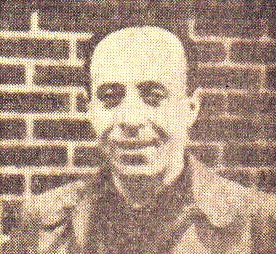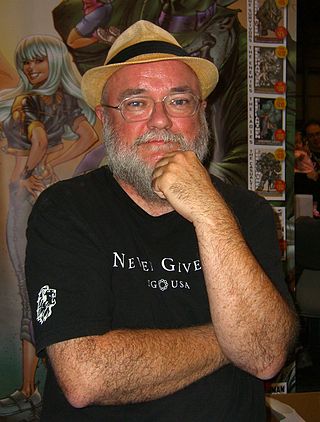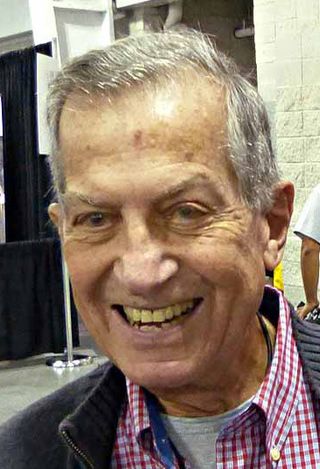William Douglas Oakley was a letterer for numerous comic books from Marvel, DC, and other companies. His most prominent works include the first two volumes of Alan Moore and Kevin O'Neill's The League of Extraordinary Gentlemen and Batman: Gotham Knights #1-11, #15-37.

The inker is one of the two line artists in traditional comic book production.

David Chester Gibbons is an English comics artist, writer and sometimes letterer. He is best known for his collaborations with writer Alan Moore, which include the miniseries Watchmen and the Superman story "For the Man Who Has Everything". He was an artist for 2000 AD, for which he contributed a large body of work from its first issue in 1977.

Todd Klein is an American comic book letterer, logo designer, and occasional writer, primarily for DC Comics.

Sam Rosen, often credited as S. Rosen, was an American calligrapher best known as a letterer for Marvel Comics during the period fans and historians call the Silver Age of Comic Books. Along with letterer Artie Simek, Rosen lettered and helped design logos for virtually all Marvel Comics published during the 1960s. Rosen also moonlighted for other companies during this time: he was the (uncredited) letterer for the 1965-66 Archie Comics series The Mighty Crusaders.

Richard Starkings is a British font designer and comic book letterer, editor and writer. He was one of the early pioneers of computer-based comic-book lettering, and is one of the most prolific creators in that industry.

Jack Adler was an artist who worked as a cover artist and colorist for DC Comics. He was a staff member of DC's production department from 1946 to 1981, rising steadily up the ranks to production manager and vice president of production.

Gaspar Saladino was an American letterer and logo designer who worked for more than sixty years in the comic book industry, mostly for DC Comics. Eventually Saladino went by one name, "Gaspar," which he wrote in his trademark calligraphy.

The Academy of Comic Book Arts (ACBA) was an American professional organization of the 1970s that was designed to be the comic book industry analog of such groups as the Academy of Motion Picture Arts and Sciences. Composed of comic-book professionals and initially formed as an honorary society focused on discussing the comic-book craft and hosting an annual awards banquet, the ACBA evolved into an advocacy organization focused on creators' rights.

Chris Eliopoulos is an American cartoonist and letterer of comic books.

John Workman is an American editor, writer, artist, designer, colorist and letterer in the comic book industry. He is known for his frequent partnerships with writer/artist Walter Simonson and also for lettering the entire run of Grant Morrison/Rachel Pollack's Doom Patrol.

Jack Morelli is an American comic book letterer and author, also credited under the name John Morelli. He has designed many comic book logos. His lettering is notable for being the basis for the computer font used by John Byrne when he letters his own work.
Comicraft is a company which provides graphic design and lettering services to various companies.
Thomas Orzechowski is a comic book letterer, primarily known for his work on Uncanny X-Men. Over the course of Orzechowski's career, he has lettered something on the order of 6,000 pages of Chris Claremont's scripts.

Ira Schnapp was a logo designer and letterer who brought his classic and art deco design styles to DC Comics beginning with the redesign of the Superman logo in 1940. He did a great deal of logo and lettering work for the company in the 1940s. Around 1949, he joined the staff as their in-house logo, cover lettering and house-ad designer and letterer, and continued in that role until about 1967.
Joe Rosen was an American comic book artist, primarily known for his work as a letterer. Over the course of his career with Marvel Comics and DC Comics, Rosen lettered such titles as The Fantastic Four, Captain America, Daredevil, Spider-Man, G.I. Joe: A Real American Hero, The Incredible Hulk, The Further Adventures of Indiana Jones, and X-Factor. He also lettered the DC/Marvel intercompany crossover book Superman and Spider-Man.
James R. Novak was a comic book creator, primarily working as a letterer for Marvel Comics, where he worked on almost every one of their ongoing series, and contributed to the development of the iconic Star Wars logo. He did occasional work as a writer, penciler, and colorist, and also worked at publishers including Dark Horse, Boom! Studios, Image, Dynamite, and IDW.
Ken Lopez is a letterer and logo designer for the comic book industry. A pioneer of computer lettering, Lopez designed the fonts for DC Comics's in-house lettering unit, and is currently DC's art director for lettering and its cover editor.
The Comics Buyer's Guide (CBG) magazine administered the annual Comics Buyer's Guide Fan Awards from 1982 to circa 2010, with the first awards announced in issue #500.

Heroes Against Hunger is a 1986 all-star benefit comic book for African famine relief and recovery. Published by DC Comics in the form of a "comic jam" or exquisite corpse, the book starred Superman and Batman. Spearheaded by Jim Starlin and Bernie Wrightson, all proceeds from the comic went to hunger relief in Africa.












